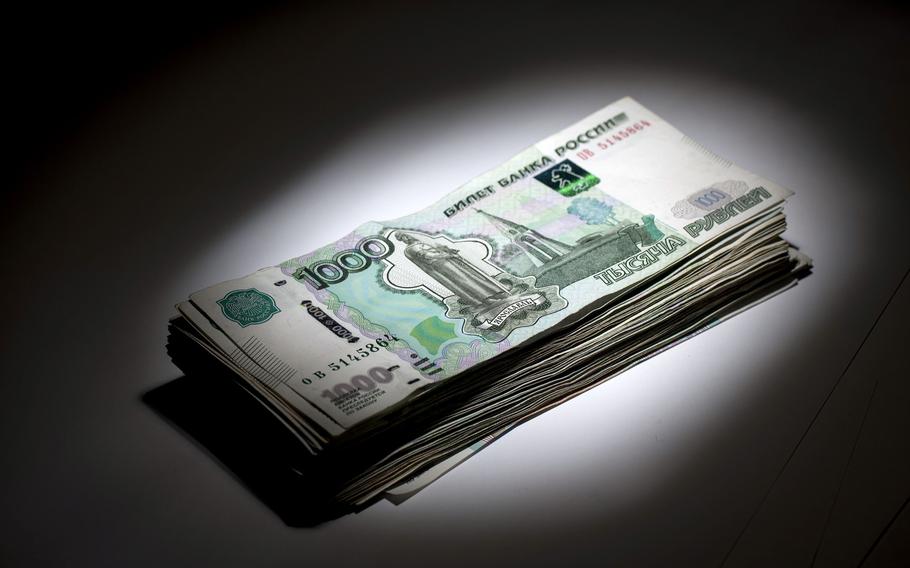
A stack of Russian 1000 ruble currency banknotes. (Simon Dawson/Bloomberg)
Russia’s central bank delivered its third interest-rate reduction in just over a month and said borrowing costs can fall further still, halting a rally in the ruble as it unwinds the financial defenses in place since the invasion of Ukraine.
The Bank of Russia lowered its benchmark to 11% from 14% on Thursday at an extraordinary meeting it announced only a day earlier. All 23 economists surveyed by Bloomberg predicted a reduction, with most forecasting a cut of two percentage points. The ruble extended losses after the announcement, heading for a two-day slump that’s approaching 12% against the dollar.
After nine percentage points of easing since April, central bank Governor Elvira Nabiullina said she still sees room for further rate cuts at meetings ahead. In a statement accompanying the decision, policymakers made little mention of the ruble beyond noting the exchange rate contributed to slower inflation.
“The coming quarters won’t be easy,” Nabiullina said at a banking industry conference, according to Tass. “While the economy is adapting it will be hard for companies and citizens.”
Encouraged by a faster-than-expected slowdown in inflation after shocks to demand, the decision shows the central bank’s determination to get in the way of the ruble’s blistering ascent even as the capital controls continue to handcuff the market. With the latest rate cut, it’s now reversed almost all the emergency monetary tightening after the invasion of Ukraine three months ago.
Despite the sweeping sanctions imposed on Russia, surging exports and capital controls have sapped demand for foreign exchange and sent the ruble soaring to the highest levels since 2018. Efforts by the authorities to slow the gains, including the easing of key capital controls earlier this week, so far haven’t helped much.
Stringent restrictions remain in place. Since the invasion, capital controls have made it impossible to sell assets and repatriate the proceeds.
In anticipation of deeper monetary easing, the ruble weakened sharply on Wednesday after gaining for five straight trading sessions. It tumbled for a second day after the decision and weakened as much as 7.7% against the dollar, the biggest drop on an intraday basis in over a month.
Still, investors were skeptical about how much policy makers can do to keep the gains from resuming because the ruble’s exchange rate is now almost entirely determined by the trade balance.
“I do not think that the decision of the central bank will help to weaken the ruble in the absence of a carry trade,” said Dmitry Kosmodemiyanskiy, an asset manager at Otkritie. “Everyone sees the trade balance and only a madman would play against it.”
The central bank also wants to provide a shot in the arm to an economy that’s on track for a sharp contraction. With the collapse in consumer demand, weekly inflation is slowing after a run-up in prices because of a spate of panic-buying in the months immediately following the invasion.
“Further easing is likely in the months ahead,” Bloomberg Economics said. “A soaring ruble and a sanctions-hit economy provide the urgency, while stable financial markets and fading price pressures are freeing policy makers to act.”
President Vladimir Putin has touted the ruble’s strength as a sign that the country has survived the unprecedented sanctions imposed by the U.S. and its allies to punish Moscow for its invasion of Ukraine.
But Russia’s oil and gas exports are mostly exempt from the penalties, sending billions of dollars and euros flowing into the country each week. Dwindling imports and restrictions on buying and sending funds abroad, meanwhile, have all but eradicated demand for hard currency.
Enough pressure built on the ruble in recent days to prompt speculation that the central bank moved up a planned rates meeting by more than two weeks to Thursday in order to temper the strongest currency rally globally.
The announcement was also published several hours earlier than the normal time on rate-decision days in Russia. There is no news conference planned with Nabiullina.
Restrictions on the movement of capital mean “rates have becomes quite irrelevant to the dollar-ruble dynamic,” according to Cristian Maggio, head of portfolio strategy at TD Securities in London who correctly predicted the decision.
“This means you may not see much ruble depreciation from here,” he said. Still, “more cuts are likely in the cards.”